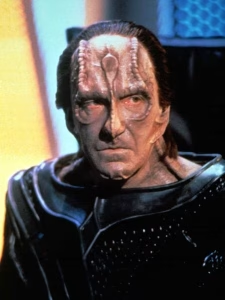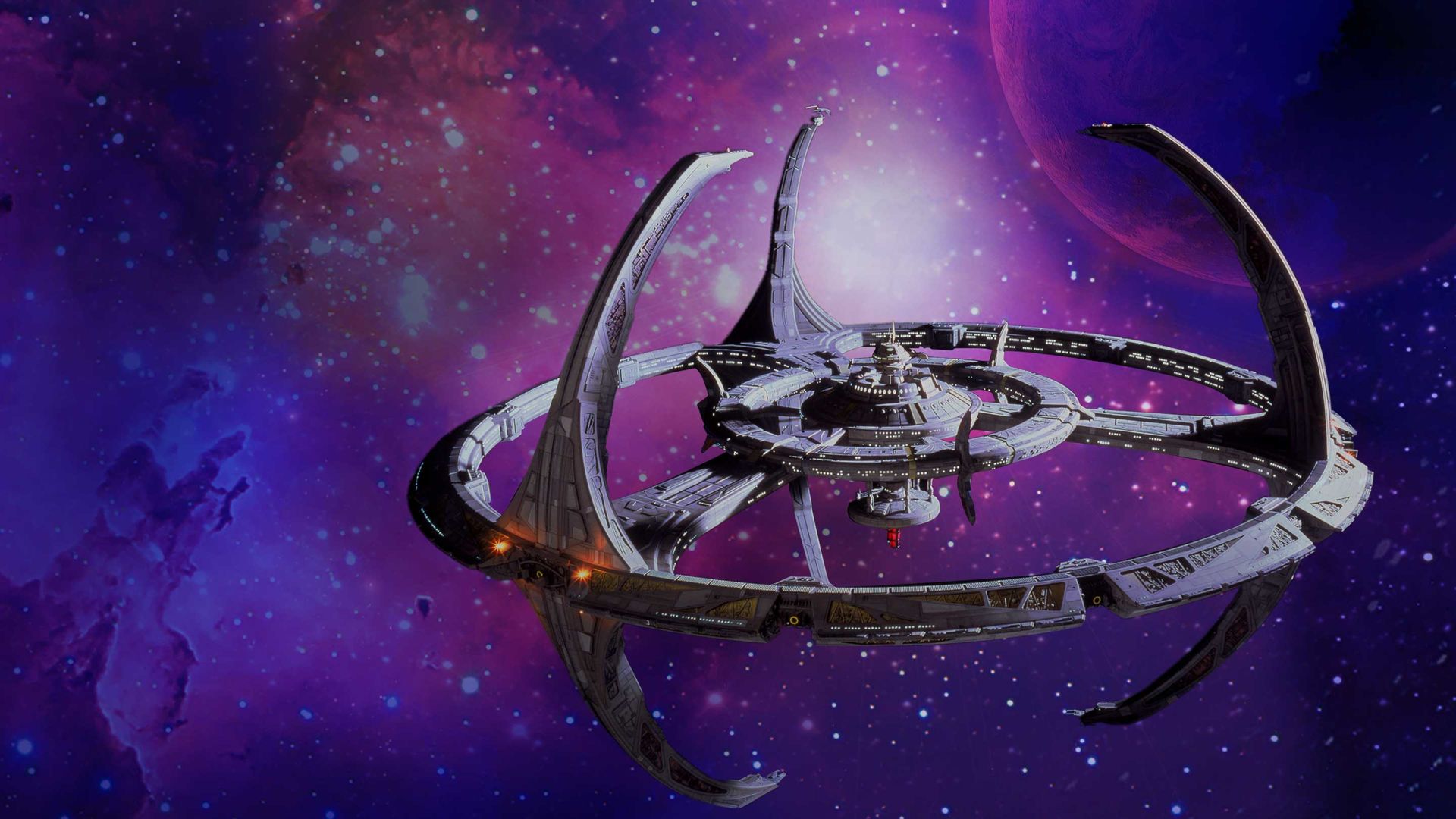I was in elementary school during the majority of Star Trek: Deep Space Nine‘s TV run.
Sorry if that made you feel old. I might not have been the most normal kid in terms of my TV preferences. Don’t get me wrong, I loved the early Nickelodeon cartoons and shows like Power Rangers that were more targeted at kids my age, but Star Trek had captured my imagination in a way that no other shows could.
It all started with Star Trek: The Next Generation, a favorite of my Dad’s at the time it aired. It had started a couple of years before I was born, and continued into my earlier childhood. I remember watching episodes of it with him when I was pre-school age and being absolutely enthralled by the settings, characters, and—in whatever way I could really understand them—the stories.
As a young school-aged kid I would ride the bus home to my grandparents’ house, where with their pole-mounted TV antenna (we were in the country, about 50 miles from Indianapolis), VCR, and plentiful spare tapes, I was able to cobble together a collection of episodes of both The Next Generation and Deep Space Nine’s earlier seasons as they aired in afternoon syndication on our local UPN station.
Classic episodes of The Next Generation like the “The Drumhead,” “Chain of Command,” and “Measure of a Man” carried their own unforgettable lessons in ethics and morality, and if nothing else were reliably enjoyable television. And one benefit of watching them as recorded reruns was that I didn’t have to wait months for resolutions to those cliffhanger two-parters like “Best of Both Worlds.”
That said, as much as I did (and still do) love The Next Generation, Deep Space Nine was the first Star Trek show that felt like it belonged to me. It was the first where I actively watched new episodes in prime time, where I was at the age to really begin to understand the themes and storylines in a meaningful way, and from where I can remember learning distinct lessons in ethics and morality that I have carried with me to this day.

While my wife was on a week-long business trip recently, I decided to conduct a quick rewatch of the series. I’ll admit, I skipped a few episodes (looking at you, Lwaxana Troi episodes) to make it from “Emissary” to “What You Leave Behind” before having to leave to pick my wife up from the airport on Friday. I probably hadn’t rewatched more than the occasional episode in over ten years, but what I remember loving about—and learning from—Deep Space Nine has remained as true as ever.
Deep Space Nine starts with a two-hour introduction to the setting, characters, and early plot of the show: “The Emissary.”
It begins with a scene that calls back to the “Best of Both Worlds” episodes of The Next Generation, but from a different perspective: that of Deep Space Nine’s main character, Commander Benjamin Sisko. In the scene, The Next Generation’s Captain Picard (Patrick Stewart) has been captured and altered by a hostile alien race called the Borg, whose weapons far outpace anything the Federation can muster against them. Having gained all of Picard’s knowledge, they are on their way to assimilate the inhabitants of Earth.

Sisko is the executive officer of the USS Saratoga, one of the Federation ships sent to counter the Borg. He is briefly addressed on the main view screen by the Borg-assimilated Picard (whose offer to surrender and be assimilated is refused), and is thrown violently across the bridge when his ship is immediately and savagely attacked by the Borg cube.
His captain and many other bridge officers dead, Sisko and the ship’s tactical officer give the order to abandon the ship. Stumbling through the destroyed corridors of the ship, he makes his way to his own cabin to find his young son unconscious and his wife Jennifer trapped under rubble, having succumbed to her injuries. The tactical officer has to pull him away from his wife’s body in order to make it to an escape pod with his son as he screams out in anguish.
Years later, he is placed in command of the titular space station Deep Space Nine. Formerly Terok Nor, it was an orbital ore refinery above the planet Bajor under the command of the villainous Cardassians as a part of their violent occupation and subjugation of Bajor. It was captured at the end of the Bajorans’ guerrilla war of independence, and the fledgling Bajoran government has asked for the Federation to help with the administration of the station as a center of defense and commerce.
Within days of arrival, he is forced to deal with rampant crime, his Bajoran first officer’s distrust of the Federation, and the Bajoran religious leader declaring him the “Emissary of the Prophets.” He also meets long-since de-Borgified Captain Picard for the first time in person since the battle where Borg-assimilated Picard was responsible for his wife’s death. Their meeting is terse, and Sisko informs Picard he intends to resign from Starfleet.
Shortly after this, a stable wormhole is detected at the edge of the Bajorans’ solar system. Sisko and his science officer, Jadzia Dax, travel in a small ship to scout and study the wormhole, finding its inhabitants to be the non-corporeal alien life-forms the Bajorans have come to revere as the Prophets. In the mean time Deep Space Nine is surrounded by Cardassian ships demanding an answer to the whereabouts of one of their ships which followed Sisko and Dax into the wormhole.
His science officer is sent by the Prophets back to Deep Space Nine while Sisko is taken by them for what amounts to an interrogation of him as a spokesperson for his species. He is forced to relive episodes from his past, coming to understand that to the Prophets time is not linear. He struggles to define his understanding of time as well as defend his species’ history and motivations.
Finally, they bring him to the moment in time from the beginning of the episode: his destroyed quarters aboard the Saratoga, his wife laying dead beneath the rubble. They accuse him of lying about his experience of time, stating that he lives here, in this moment as much as he does in his present. Eventually he relents and admits that he has never left this moment, that it is something he relives every moment of every day.
And that, friends, is the first lesson I learned from Deep Space Nine. We may experience time linearly, but a part of us continues to live in our darkest moments of loss and pain.
Sisko’s realization in this first interaction with the Prophets is that while a part of him may never leave that moment of pain, he has left too much of himself behind and allowed it to define himself. He has never allowed himself to experience that moment as anything other than himself from the past. Being able to experience it as himself in the present allows him heal.
Eventually he is released by the Prophets—along with the lost Cardassian Ship—just in time to arrive back at Deep Space Nine and prevent a new war between the Cardassians and Federation/Bajorans. He speaks with Captain Picard again, and with a new energy and disposition informs him that he does not actually want to leave Starfleet and will remain in command of Deep Space Nine.
I would imagine most, if not all of us have been through experiences so painful that we have left behind a part of ourselves in the moment. I believe that is the nature of grief: we experience a loss of something—most often someone—that has become a part of who we are. We cannot go back in time and take back all of that part of ourselves. At least part of us will always live there, but by letting it go as best we can, we allow ourselves to fill in some of that empty part of ourselves with our present life.

Be First to Comment